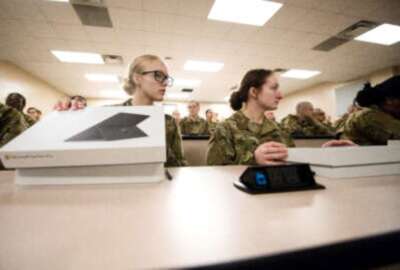Editor’s note: While Tom Temin is away please enjoy this column which originally published Aug. 28, 2020.
Best listening experience is on Chrome, Firefox or Safari. Subscribe to Federal Drive’s daily audio interviews on Apple Podcasts or PodcastOne.
Ever been to Kohler, Wisconsin? I have. It’s a company town, literally. In another century, the bathroom fixture manufacturer built neat rows of houses for its factory employees. The little houses still stand, and the company still maintains the authority of a homeowner association. Go some day, if only to see the Wall of Toilets.
Village founder Walter Kohler (son of the company founder and a one-term Wisconsin governor) had an idealized vision for work-life balance of his employees.
In the age of mass telework, the relationship between employee and employer has a new element, and this is true of the federal government. Namely, whether people are generally happy. Through all of the glowing reports of high employee productivity and technological reliability of telework tools, a dark beam pierces.
Loneliness is apparently on the rise. An August survey by Blind of technology employees found loneliness, dread of work, anxiety and other mental bugaboos on the rise. This is driven by the isolation in the so-called new normal of working from home.
Employees seem to sift into a few basic buckets. Those who love teleworking and never want to go back, those who hate it and desire the daily contact and interaction with people in person, and switch hitters.
In an earlier column on pandemic fatigue I referred to how the Office of Special Counsel, a tiny agency, is offering “wellness Wednesdays” and other measures to help people maintain equilibrium. Turns out agency head Henry Kerner is not alone.
In an interview with Bill Bryan, the head of the Science and Technology Directorate at the Homeland Security Department, he describes how he became a personal convert to teleworking, and how agency effectiveness has somehow improved during the pandemic. For instance, attendance, albeit virtual, has increased 10 times at S&T’s workshops and industry days. I asked why — given some of those numbers, and with employee satisfaction polls on the rise — he’d ever want to reopen office to the old ways.
“That [question] is in forefront of all the minds of all the leaders who are going through this time,” Bryan said. Federal managers face a real conundrum. Productivity is up. Job satisfaction is up. Abhorrent commutes for many people are a thing of the past. Employees with special requirements, such as family member care or kids in not-school, may find their personal issues easier to deal with if they don’t have to traipse to the office every day.
And yet, there’s the persistent cross-current of morale and mental health issues among some precisely because of the physical isolation of telework.
The answer seems to be a hybrid. Some people will return but not all. Bryan openly wondered whether more than 50% of the S&T employees will ever return permanently to the office. For those who don’t, managers must monitor their psychic well-being and have programs and procedures for helping people stay engaged.
“For me it was really important to try and take the work environment, and lessen the stress on the employees and allow them to really be able to build a life and structure their home around being able to do this effectively and efficiently,” Bryan said. All this, “while still maintaining their families and all the other responsibilities now thrust on them that in the beginning they didn’t have.”
Bryan has deployed the same technical platform that enhances collaborative work among scattered people — in this case Microsoft Teams — to enhance employee wellness. Yoga, weekly “community comfort chat calls,” work-life balance workshops, and after-hours “watercooler” meetups all occur on Teams.
As a manager you should never play psychiatrist or doctor. You’re not paid for that, and you can’t do it competently, much less safely or legally. I recall a couple of employees from my managerial days who had clinical depression or abusive partners for which the organization could only suggest referrals. Your responsibility is getting the work done. Yet management is the art of getting things done through people. So it stands to reason that a physically and mentally healthy work environment is your responsibility — including if the environment is not under one roof. You have the power to alter workloads, juggle and reassign, or encourage taking earned time off and meaning it. You have the responsibility to hear people out.
Bob Tobias, a regular Federal Drive guest and a long time practitioner and educator in federal workplace issues, put it this way: “As a leader, are the people I lead feeling lonely because of COVID, because of a lack of seeing and being with other people? And what do I need to do about it?” You can call people to personally check in. You can establish phone trees so, in a large organization, everyone gets a call. When you do call, be sure to listen.
Nearly Useless Factoid
By Alazar Moges
The current president is the wealthiest America has ever had. But did you know that our first president, George Washington, was also extremely wealthy. Adjusted for current times his peak net worth, much of which was inherited, is estimated around $587 million, making him the third wealthiest ever behind President Trump and President John F. Kennedy.
Source: VOA
Copyright
© 2024 Federal News Network. All rights reserved. This website is not intended for users located within the European Economic Area.





